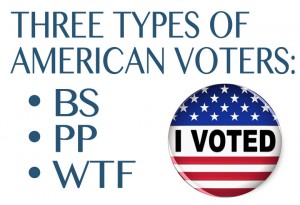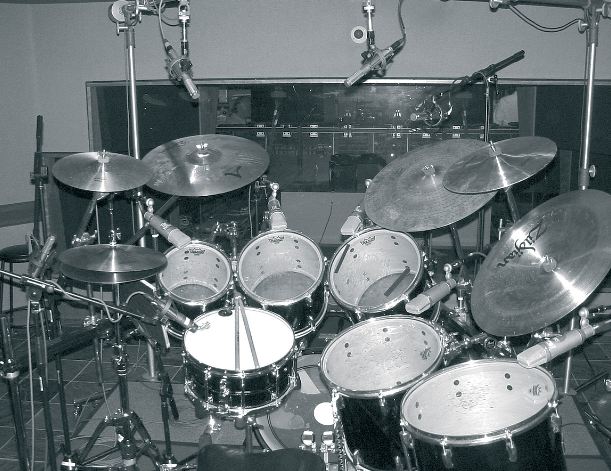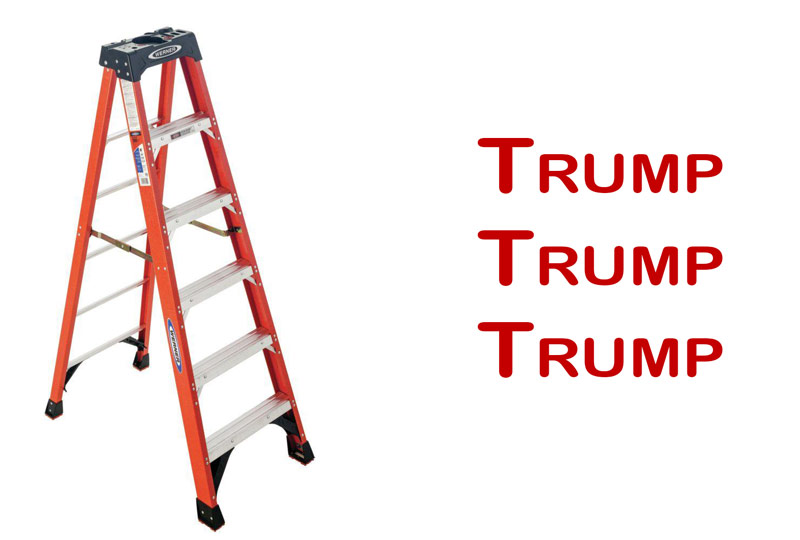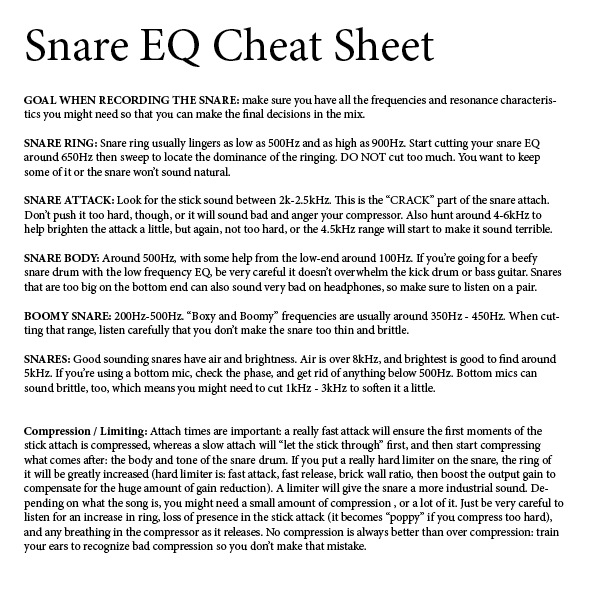
Related Article: Fix a bad snare drum sound
The snare drum can sit nicely in your mix, or it can be a total nightmare. Mixing drums isn’t easy. EQing and compressing a snare is a big part of getting a good drum sound, so you want to practice the techniques we mention in this post. Always remember: there’s no single answer for a perfect snare drum sound – it has to fit the song. The point of these tips are to add a few ideas to your mixing toolkit.
First, however, I need to mention the importance of the recorded snare drum sound, so let’s briefly talke about recording a snare drum.
When recording a snare: get more than you need
When recording a snare, people sometimes get scared of “too much” happening in the sound: too much ring in the snare, too boxy, too boomy, too much low end, etc, etc… don’t be afraid of that stuff. Never take out too much of those sonic aspects while recording a snare drum! Have a “save it for later” approach when recording so you have it if you need it when mixing. If you remove too much when recording, then you’re boxing yourself into a corner for the mix.
You want a little boom in your snare, and a little ringing – the point is that you want these characteristics to be “available” in the recorded snare, so that when you start mixing all those frequency pieces are present in the snare recording, which gives you many, many more options to shape it in the mix. If you EQ a snare drum too hard while recording then it’s a lot harder to get back what you cut. It’s perfectly fine to deaden certain annoying frequencies (snare drum frequencies listed below), control some of the ringing, etc., but also remember that the ring very much helps define the tone of the instrument, so if you remove it completely, then it becomes a dead sound without any character at all.
The bottom line is: leave yourself enough tone, ring, and body when recording the snare, then make the final decisions with compression, gates and EQs in the mix. I cannot understate how important that is.
EQ Tips and Frequencies for Snare Drum
Ring in a Snare. Snare ring usually lingers between as low as 500Hz and as high as 900Hz (start cutting with your snare EQ around 650Hz to locate the frequency of the ringing You want a fairly narrow Q width on that band, but not too much). However, be careful because the low-end of this range is also where you’ll get body to your snare sound… you don’t want it to be too hollow sounding or thin, so don’t cut too much and do so with a narrow Q value.
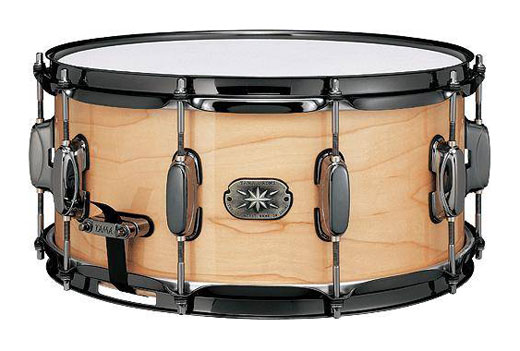 Snare Attack. The stick of the attack is around where our ears are most sensitive 2-2.5kHz. This is the real “CRACK!” part of the attack sound. EQing a snare drum up in that range will give more crack, but again: be careful! It can sound bad really fast if you push it too hard. Pulling that frequency range back will soften the attack, boosting it can help bring it out, but be careful because too much of that range can make the actual snares sound very “plastic-y” and brittle rather than the softer snares that people tend to like (more on snares sound below).
Snare Attack. The stick of the attack is around where our ears are most sensitive 2-2.5kHz. This is the real “CRACK!” part of the attack sound. EQing a snare drum up in that range will give more crack, but again: be careful! It can sound bad really fast if you push it too hard. Pulling that frequency range back will soften the attack, boosting it can help bring it out, but be careful because too much of that range can make the actual snares sound very “plastic-y” and brittle rather than the softer snares that people tend to like (more on snares sound below).
Next Page: Fix Boomy / Boxy Snare EQ & Snare Compression Settings
Snare body / beef. It’s perfectly OK to have some low-end that you’d normally think should only be for the kick drum in your snare sound. Not “HUGE” or anything, but a little to give some more beef to the punch of the snare drum. You also have a lot of tone down there (90Hz – 150Hz) with which you can experiment a little bit. Again, don’t push it hard, but don’t always cut it, either. The low frequencies can help with the “bigness” of the snare in your drum mix.
Snare body / boomy. The 200-500Hz range is tricky. There’s lots of body and fullness there, but there’s also the dreaded “boxy and boomy” frequencies (usually around 350Hz – 450Hz). So while cutting 350 can help tighten up the snare, it can also result in it lose a lot of fullness. Try narrow EQs and using compression before the EQ to see if that can help get some control over the lower frequencies before you start EQing in the signal chain.
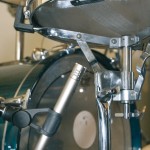 The snares in a snare drum (particularly if you double mic’d the snare drum and put one on top and bottom). Microphones on the bottom of a snare drum can sound very brittle and… well, bad, without EQing. Blended softly with a top mic, though they can help your mix a lot. Bottom snare mics often sound surprisingly plastic. The plastic, brittle sound of a bottom snare EQ tends to sit between 1kHz and can sweep up as high as 3kHz. First try a wide Q and pull that back that range. This will make it a little bit brighter, more airy sound of the snares come through more. (And don’t forget to listen for phase issues and flip the phase on the bottom mic if you hear any phase problems.) Don’t go crazy because you normally don’t want to blend the bottom snare mic very high. You want the bottom snare mic blended just enough to make a subtle difference and ensure the snares are heard, but not dominant in your overall snare sound.
The snares in a snare drum (particularly if you double mic’d the snare drum and put one on top and bottom). Microphones on the bottom of a snare drum can sound very brittle and… well, bad, without EQing. Blended softly with a top mic, though they can help your mix a lot. Bottom snare mics often sound surprisingly plastic. The plastic, brittle sound of a bottom snare EQ tends to sit between 1kHz and can sweep up as high as 3kHz. First try a wide Q and pull that back that range. This will make it a little bit brighter, more airy sound of the snares come through more. (And don’t forget to listen for phase issues and flip the phase on the bottom mic if you hear any phase problems.) Don’t go crazy because you normally don’t want to blend the bottom snare mic very high. You want the bottom snare mic blended just enough to make a subtle difference and ensure the snares are heard, but not dominant in your overall snare sound.
Compression / Limiting A Snare. (also see hard vs soft limiter settings). The threshold setting is almost entirely dependent on the input level of the signal, so there is no magic setting for that. To get you started, set your compressor in this order:
- Set the ratio as your gut tells you you’re going to want to start. If you’re not sure, just set 4:1.
- Start decreasing the threshold until you have some gain reduction. You’re really going to start to head the compression once you get over -8db to -10db attenuation. Listen for it.
- Now adjust the attack and release times. Those two settings will change the “vibe” of the sound, can cause or prevent clicking sounds, and cause the compressor to pump or breathe.
- Adjust the make-up gain to boost the signal back up so it’s workable (rule of thumb is to boost the same amount as the gain reduction you’re getting; just make sure you don’t go too far where it starts clipping).
Again, compressor settings for a snare depend on what’s recorded and how you want it to sound. A safe ratio is 4:1, you are getting aggressive around 7:1, and you start to get into limiter territory around 12:1 (some say 10:1). The key is you need to know how each sounds. That’s why I say start with a ratio in mind. The more you practice the more you’ll get a feel for what sort of ratio you want based on how you want it to sound. You want to look at the gain reduction meter when compressing. For snare drums, you can get a lot of gain reduction before it starts sounding bad, 10-15db.
Attack times on your compressor are very important; that’s what determines how much of the uncompressed attack “gets through” the compressor before it starts compressing the snare. A really fast attack will ensure the first stick attack is compressed, whereas a slow attack will “let the stick through” and then compress the body and tone of the snare drum more.
If what attack times do doesn’t yet make sense: practice! Make your settings too extreme so that you’re ears learn what bad compression sounds like, try to get breathing in your compression, but do it so that you get how attack and release times can impact your sound. As you start to compress a snare drum you’ll also subtly lose some of the low frequencies (so try that rather than cutting with an EQ to see if it helps). If you put a really hard limiter on it, the ring of the snare will be greatly increased (wicked hard limiter, then boost your output gain a lot to compensate). That will give you more of an industrial sound. Depending on what the song is, you might need a tiny bit of compression, or a ton of it. Just be VERY careful to listen for increases in ring, lost of presence in the stick attack, and quick breathing of the compressor. No compression is better than over compression.
Listen and practice. Good luck!






